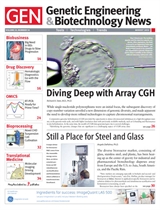Sep 16 2013
Researchers at the University of California-San Diego have developed a novel strategy to identify cancer subtypes not by the single mutations of individual patients, but by how those mutations affect shared genetic networks or systems. They published their paper ("Network-based stratification of tumor mutations") in the September 15 advanced online edition of Nature Methods.
"Somatic tumor genome sequences provide a rich new source of data for uncovering [cancer] subtypes but have proven difficult to compare, as two tumors rarely share the same mutations," wrote the scientists in their article. "Here we introduce network-based stratification (NBS), a method to integrate somatic tumor genomes with gene networks. This approach allows for stratification of cancer into informative subtypes by clustering together patients with mutations in similar network regions."
The most basic step toward achieving personalized medicine is subtyping, according to Trey Ideker, Ph.D., division chief of genetics in the UC San Diego School of Medicine and a professor in the departments of medicine and bioengineering at UC San Diego.
"Based on patient data, patients are placed into subtypes with associated treatments," he explained. "For example, one subtype of cancer is known to respond well to drug A, but not drug B. Without subtyping, every patient looks the same by definition, and you have no idea how to treat them differently."
However, Dr. Ideker calls genes "wildly heterogeneous." It is in combination, influenced by other factors, that mutated genes cause diseases like cancer. Every patient's cancer is genetically unique, which can affect the efficacy and outcomes of clinical treatment.
"When you look at patients' data at the level of genes, everybody looks different," noted Dr. Ideker. "But when you look at impacted biological networks and systems, groupings do appear. No genes are mutated in exactly the same place, but the mutations do appear in the same genetic pathways."
The research team applied their NBS technique to data derived from ovarian, uterine, and lung cancer samples from The Cancer Genome Atlas.
"For each tissue, NBS identifies subtypes that are predictive of clinical outcomes such as patient survival, response to therapy, or tumor histology," continued Dr. Ideker and his colleagues in the Nature Methods article. "We identify network regions characteristic of each subtype and show how mutation-derived subtypes can be used to train an mRNA expression signature, which provides similar information in the absence of DNA sequence."
Dr. Ideker believes the NBS approach has immediate clinical value. Genome sequencing of cancer patients is rapidly becoming a standard part of diagnosis. Clinicians can use NBS, he said, to better match treatment to cancer subtype. By chronicling treatment outcomes and funneling those results back into the database, they can further refine and improve cancer therapies, making them as personalized as the individuals themselves.
The UC-San Diego group also thinks the NBS system can lead to valuable new insights in the study of cancer.
"Finally, analyzing NBS subtypes across all cancers simultaneously (i.e., a pan-cancer analysis) will offer the intriguing opportunity to explore whether the genes and networks underlying the progression of a tumor are more informative of clinical outcome than its tissue of origin," they wrote.

 This article was reprinted from Genetic Engineering & Biotechnology News (GEN) with permission from Mary Ann Liebert, Inc., publishers. Genetic Engineering & Biotechnology News (GEN) has retained its position as the number one biotech publisher around the globe since its launch in 1981. GEN publishes a print edition 21 times a year and has additional exclusive editorial content online, like news and analysis as well as blogs, podcasts, webinars, polls, videos, and application notes. GEN's unique news and technology focus includes the entire bioproduct life cycle from early-stage R&D, to applied research including omics, biomarkers, as well as diagnostics, to bioprocessing and commercialization.
This article was reprinted from Genetic Engineering & Biotechnology News (GEN) with permission from Mary Ann Liebert, Inc., publishers. Genetic Engineering & Biotechnology News (GEN) has retained its position as the number one biotech publisher around the globe since its launch in 1981. GEN publishes a print edition 21 times a year and has additional exclusive editorial content online, like news and analysis as well as blogs, podcasts, webinars, polls, videos, and application notes. GEN's unique news and technology focus includes the entire bioproduct life cycle from early-stage R&D, to applied research including omics, biomarkers, as well as diagnostics, to bioprocessing and commercialization.